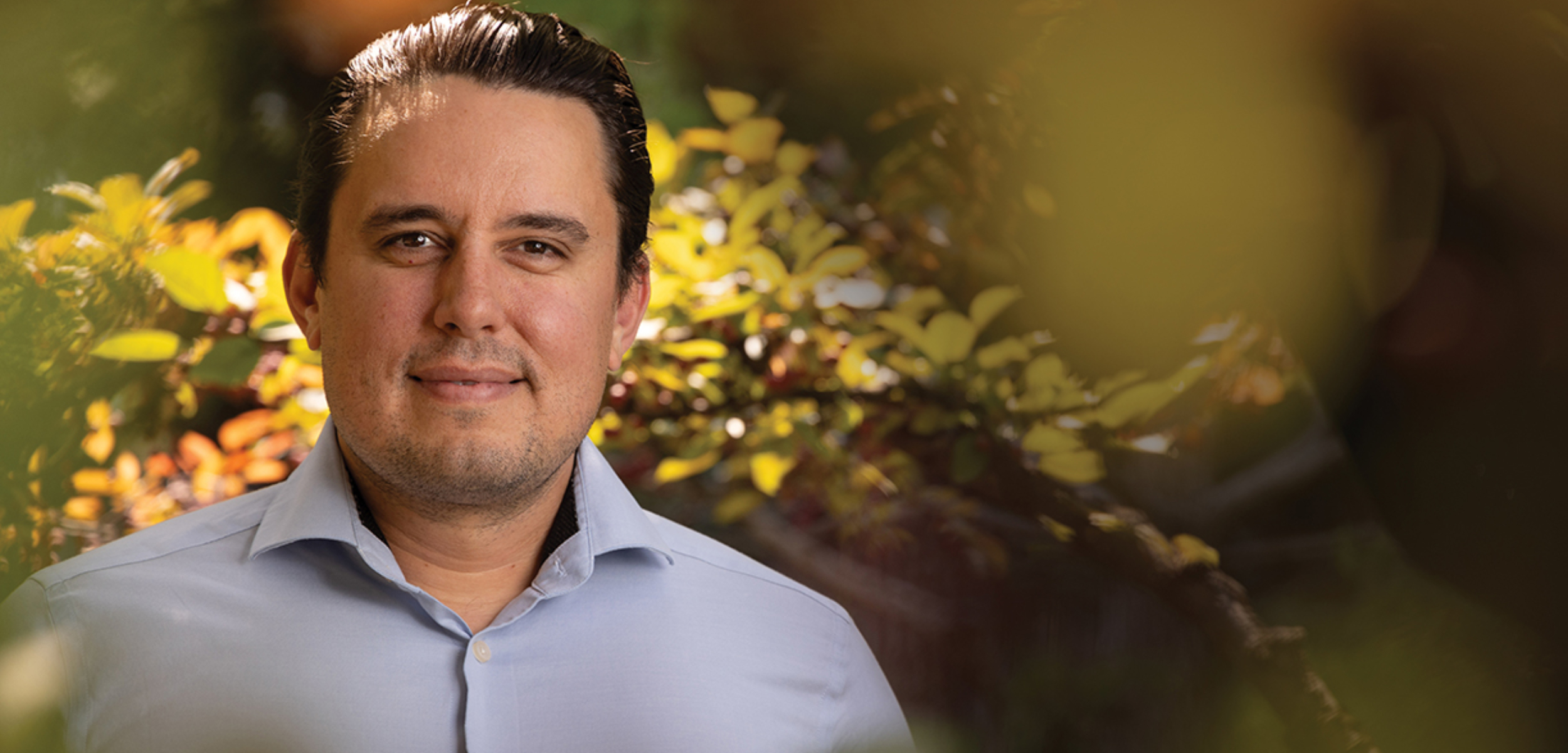
After another summer of record-breaking heat, severe wildfires, rising ocean temperatures, extreme weather events, and devastating ecological disasters across the world, it’s becoming clear that if humans want to have a livable planet for current and future generations, we must take urgent and decisive action to address climate change.
It is with this urgency in mind that CWU Sustainability Officer Jeff Bousson has gone about creating a campus-wide network of collaborators for the university’s upcoming Climate Action Plan, which will outline an ambitious pathway to reducing our greenhouse gas emissions by 45% by 2030, and build out new sustainability initiatives with the overarching goal of becoming a zero-carbon campus in the next 15-20 years.
“It’s becoming more difficult to ignore the climate crisis, which means I don’t have to spend a lot of time trying to convince people of the urgency of the challenges we face,” Bousson said. “We know for a fact that human activities, such as burning fossil fuels like gas and coal, are primarily causing the changes we are seeing in the Earth’s climate, and we have a pretty good idea of what we can do about it, too.”
Over the past year, Bousson has been hosting Sustainability Cafés (which will be known as CWU Sustainability Forums going forward) and facilitating other opportunities to gather community input and feedback on this upcoming comprehensive plan. He stresses this will require a sense of shared responsibility and ownership across campus to achieve a safe, resilient, and equitable zero-carbon future.
Since sustainability is a deeply complex concept, with nuance that stretches into every conceivable field of study—as well as every department on a college campus—Bousson noted that it has been imperative to bring together as many campus partners as possible, in order to benefit from their expertise and ensure no potential burdens or challenges are being overlooked.
“There’s so much intellectual capital that we can leverage from faculty, staff, students, and community partners” he said. “That’s what sets us apart as an academic institution. It’s the unique connections and expertise we have here on campus, and our willingness to listen and learn from each other, which ensures that a diverse array of ideas are being brought to the table and we approach this work with creativity and open-mindedness. We need all the help we can get to find the gaps in our plan. What are we missing? What are the things we haven’t even thought about in terms of how our efforts to address climate change could disproportionately burden the most vulnerable members of our community?”
Because sustainability is an issue that must be tackled on multiple fronts, the Climate Action Plan is structured to begin work on each of these issues simultaneously.
••••••••
Innovation in Action
One of the biggest contributors to CWU’s greenhouse gas emissions is our dependence on natural gas for heating and cooling via the campus-wide network of steam ducts. With the $103 million North Academic Complex (NAC) replacing Farrell Hall and the Language and Literature building within the next few years, Capital Planning and Projects is taking the opportunity to address the natural gas issue through the construction of a geothermal well on north campus, capable to heating and cooling up to 500,000 square feet of space using the naturally occurring aquifer underneath campus.
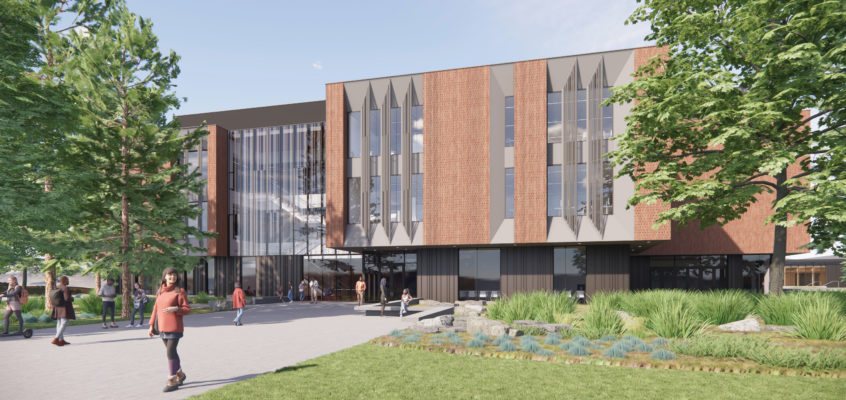
An architectural rendering of the North Academic Complex (NAC), which will be heated and cooled by a nearby geothermal well.
This trail-blazing technology will be housed partially in a see-through building, allowing students to see the inner workings of the kind of solution that may one day end up sustaining our world.
“What this helps teach our students is that there’s more than one way to help the planet by reducing our carbon emissions, and even though one approach might have historically worked well, it might not be the best option in the long run,” said Director of Capital Planning and Projects Delano Palmer. “The wheel is a great invention, but people have always been coming up with new tires, axles, and drive trains to advance what it’s capable of, just like we’re doing with our approach to sustainability. We owe it to ourselves to constantly challenge the status quo.”
Palmer explained that Capital Planning and Projects’ involvement with this work is much broader than the other NAC projects, extending into every on-campus building. Since the Ellensburg campus is made up of buildings of varying age, opportunities to address inefficiencies are everywhere. They also carry with them the possibility of enhancing students’ education.
“A lot of the students here are going to be first-generation students,” Palmer said. “We want to offer them the most incredible first impression of the collegiate experience that we can, and to do that, we need to be constantly innovating and improving on the spaces they see when they come to campus. It needs to be inviting, inspiring, and educational, all in one, and with these new building projects, we have an opportunity to elevate that.
“Spaces like our new Health Sciences building are designed to become their own living classroom, surrounding students with knowledge and inviting them to learn more at every turn, and that’s what we want to do with the North Academic Complex, too.”
••••••••
Education for Tomorrow
As the campus’ buildings are being upgraded for efficiency and enhanced learning, faculty are being encouraged to infuse sustainability into their curricula to prepare students for a job market that values such practices. Chief Financial Officer Joel Klucking explained that these sustainability efforts play into CWU’s commitment to prepare students for the real-world application of their education.
“It’s a whole sector that’s quite small right now, but will be much, much bigger in the near future,” he said. “Preparing our students to think in terms of sustainability will make them incredibly valuable employees in tomorrow’s job market. Colleges in general have been on the vanguard of responding to climate issues going back as far as the ’60s.
“One of our main charges is building sustainability knowledge and understanding, and equipping our community to think about the challenges we face in this regard. Embedding that in our curriculum is really important.”
A group of eight Information, Technology and Administrative Management (ITAM) master’s students recently were presented with the opportunity to aid the SURC’s preparations for becoming a community shelter in case of an environmental emergency (e.g., community power going out as a result of a natural disaster). Senior Lecturer Elizabeth Fountain, who introduced her students to the project, said it helped them see themselves contributing to the cause as they enter the workforce.
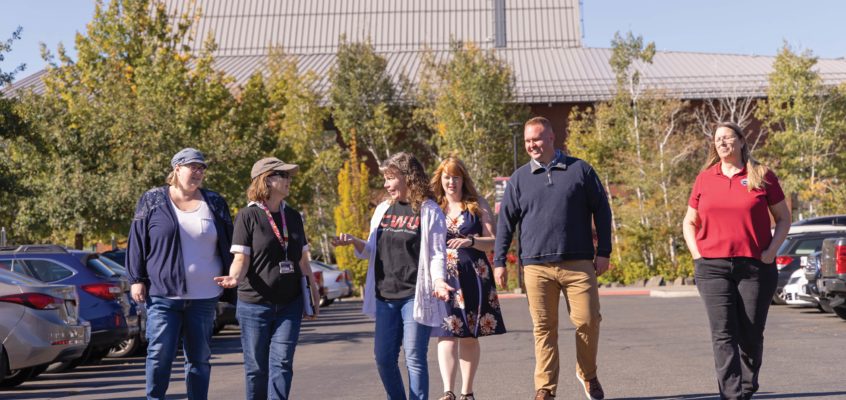
Senior Lecturer Liz Fountain (second from left) talks with students Corinne Grieve, left, Adrienne Zimny, Vernée Hemphill, Angus Beaton, and Kelly Zakel-Larson about their proposed project to install solar-paneled covered parking in the SURC parking lot.
“There are sustainability aspects to practically every field out there,” she said. “A lot of my students had never seen themselves taking an active role in sustainability work until we did this project, and it has really broadened their horizons.”
The students were tasked with conducting a feasibility study of installing a smart, solar-powered microgrid in the SURC, which would allow the building to remain powered and operational in case of a failure of the local electrical grid. After examining similar efforts across the globe, the group determined that the best way forward might be a solar canopy constructed over the SURC parking lot, as the angles of the building’s roof are not ideal for efficient solar paneling.
“These are the things that make me proud to be at CWU,” said Vernée Hemphill, a student in Fountain’s class and an alternative media specialist with Central Access. “The fact that we’re even playing with the concept of a solar canopy speaks to the school’s commitment to its cause, and the fact that we got to apply our classwork to a real-life, local subject was very cool.”
While the decision on whether to implement the solar canopy concept is pending, the benefits of involving students in the planning process are undeniable. Adrienne Zimny, another student in the class and a program coordinator with Central Access, says the process gave her and her fellow students a new appreciation for what they can contribute to the campus.
“This is a great approach to reaching all students in a meaningful way,” she said. “It’s one thing to have the opportunity to volunteer your time outside of class, but to have it actually tied in with our classwork gave so much depth to the project and our learning. It gives you that pride factor, and makes you feel like you’re contributing to your school.”
••••••••
Vision and Mission in Focus
Besides properly preparing our students for the world to come, this work will also help CWU live into our new mission, which includes the phrasing: “We are committed to fostering high-impact practices, sustainability, and authentic community partnerships that are grounded in meaningful relationships.”
Klucking believes the inclusion of sustainability is more than just marketing.
“Sustainability is baked into our mission statement in order to keep it a priority for our institution,” he said. “This cements it as an intrinsic feature of who we are as a school, and what our purpose is. That’s how committed we are to seeing this work through.”
Bousson added that another key piece of the puzzle in meeting that expectation will come in the form of community-led, peer-to-peer education.
“On a personal level, making lifestyle changes and reducing your footprint is a positive for sure, but at the institutional level, I think we have the opportunity to inspire a lot of action and engagement,” he said.
“I often hear from people that they feel they can’t do enough to make a difference, but work like this really proves that when we come together, we can achieve incredible things. When we have students, staff, and faculty recognizing that their voices matter, and this is an opportunity to make a positive difference, that helps alleviate some of the understandable anxiety about the situation we find ourselves in.”
Composting, sustainable food sourcing, emissions reduction, transportation, energy efficiency, and peer education are all just a small part of the multi-pronged approach being developed by Bousson, the Sustainability Council, and several departments across campus, in partnership with the City of Ellensburg.
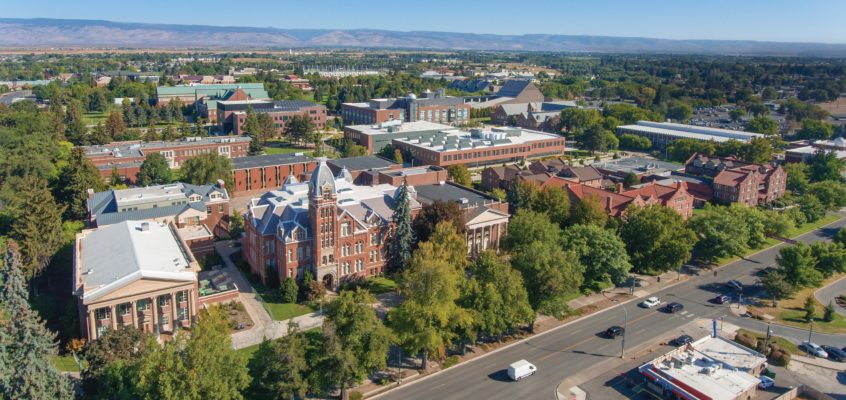
Constituents across the institution are coming together to put CWU’s Climate Action Plan into motion.
While CWU’s Climate Action Plan is complex and ever-evolving, its payoffs are straightforward and universally beneficial. Cleaner air, lower energy costs, and students equipped with the tools they’ll need to help move the whole world forward are all rewards the university could reap through these initiatives. CWU Sustainability anticipates that the Climate Action Plan will be completed in February 2024, which will create several opportunities for the campus and local communities to be involved in the implementation of decarbonization strategies for many years to come.
This approach also makes clear to prospective students that we walk our talk.
“Having a plan and taking our climate action seriously makes us a much more attractive university for students,” Klucking said. “People want to see that we’re doing our part in addressing the needs of the climate, and leveraging our position as a university to educate the public.”
Bousson wants alumni to get involved in the sustainability efforts, too, as their workplace experience, connections, and passion for their alma mater would all be boons in the ongoing effort to corral the kind of collaboration necessary to see this work through.
“We have a long way to go, but there are a lot of reasons for optimism, too,” Bousson said. “There is not a more exciting time to be working in the sustainability space, and with the kind of engagement, support, and commitment we’ve experienced already, Central is going to be a leader in the field for many years to come.”
Interested in supporting our sustainability initiatives? Email sustainability@cwu.edu.


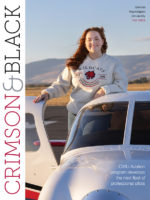


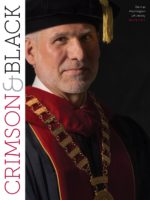
comments powered by Disqus